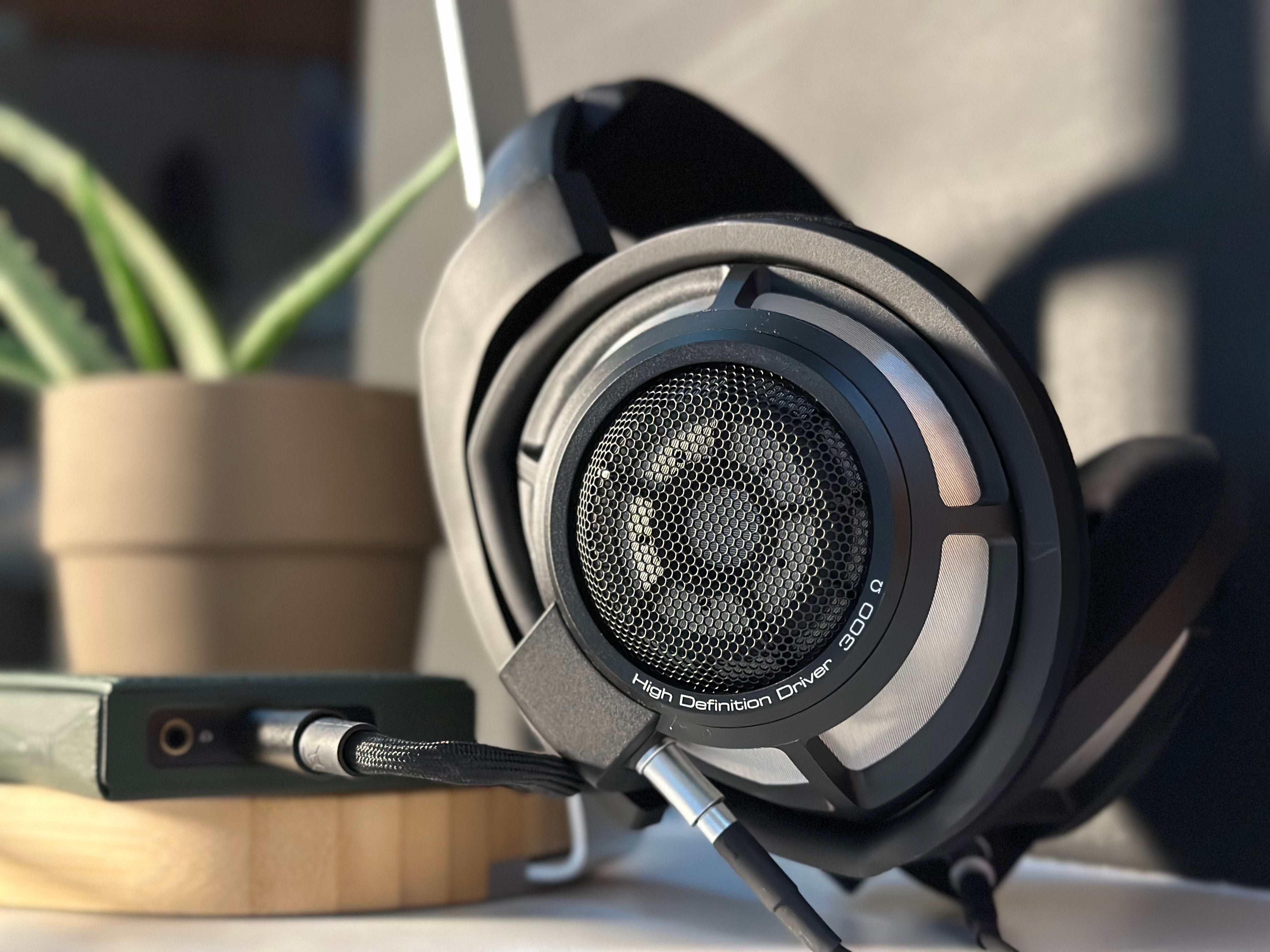Sennheiser HD800S’ lineage goes back to Sennheiser's release of the original HD800 in 2009 – or possibly even the HD600 in 1997 – which is to say, it has deep roots in the history of HiFi headphones. HD800 was known for its highly detailed, analytical sound which led to it being considered somewhat of a “microscope” for critical listening, but it was also prone to causing listener fatigue and perhaps a little too incisive for more relaxed listening.
In 2016, HD800S was introduced as an improved version of the HD800, which preserved characteristics like the imaging and detail while reducing harsh frequencies and providing a more well rounded listening experience. Now six years later after the release of the HD800S and 13 years after the original HD800, how does it hold up in the modern personal audio scene?
Build, Design, and Packaging
HD800S has a unique look and is one of the most instantly recognizable headphones out there. The construction is solid, and a lot of careful engineering clearly went into the sonic characteristics, style, and durability in a total design package. The mix of aluminum and plastic doesn’t always match the luxurious feel of some higher end headphones, but the comfort is top notch, with a lightweight design and “all day” comfortability.
The box and package provide a generally strong presentation. Along with the headphones it contains 6.3mm and 4.4mm cables, and a small collection of other accessories to go along with your purchase. The manual comes as a printed physical book, and HD800S includes a branded USB stick with a PDF of the manual. There’s also a cloth carrying bag – more of a dust cover for storage than something I would use to transport the HD800S.
Sound
It’s very easy to understand why HD800 became so popular, between the wide soundstage, highly resolving presentation, and transparency. The level of detail is still among the best out there, and H800S remains a benchmark for other headphones in terms of its detail retrieval and delivery of a spacious stereo image.
The bass is natural if slightly rolled off, and provides a clean, articulate low end that isn’t afraid to give you some punch when it’s appropriate. The mids are where most of the action is, with a rich presentation of detail and a natural timbre. Instruments and voices are layered immaculately with each possessing excellent detail and texture. The treble offers good extension and strong definition, but is surprisingly non-fatiguing, given the level of presence in the upper end. The overall tuning sometimes feels just slightly bright, but is generally neutral.
HD800S has a reputation for having a great soundstage, and that reputation is well earned. It is wide, spacious and three-dimensional, providing an incredible canvas for the music to play on. The imaging is likewise strong, offering strong separation combined with a broad sense of cohesion and coherence.
HD800S gives you tight sizzle on the hi-hats along with a highly detailed bassline, and intimate, holographic vocals on classic 80s track “Everything She Wants” by Wham. The resolution on the synth stabs is notable, with a fast attack, natural decay, and a detailed presentation. The percussion has a tight physicality as well, adding a fun energy to the song. The only thing it left me wanting was just a little more impact on the bass hits, but it was an otherwise surprisingly fun delivery of the song from a headphone not known for its “fun” characteristics.
Aphex Twin creates the kind of music that you can listen to in two ways: either with a warmer, lusher bass heavy headphone that you can use to just get lost in the beats, or with a more analytical one to get lost while unwrapping each layer of the song. HD800S is perfect for doing the latter. “Ageispolis” delivers his trademark sound in an arrangement that ebbs and flows, building on a central element, deconstructing and then reconstructing something new around the same basic drum loop. The track hits the bass hard, giving HD800S quite the workout, while also offering thick layers that HD800S can take its trademark microscope to and offer to the listener with all of their detail and intricacy.
While HD800S can certainly hang on rock and electronic tracks, it’s most at home with classical music. The recently released Beethoven for Three album, featuring Yo-Yo Ma, Emanuel Ax, and Leonidas Kavakos, offers plenty of opportunities to appreciate the detail, layering, imaging, and also the timbre of HD800S. The violin and cello are rich with texture, letting you feel the vibration of the bow and the friction of the string. The piano has a subtle brightness and spritely energy in the upper ranges, and a weight and impact when Ax lets his left hand get heavy. The sense of space, positioning and blending is exquisite – a testimony to the musicians, the production of the album, and the precise but natural delivery of HD800S
On Led Zeppelin’s “Kashmir,” the instruments feel as if they’re spread across a wide space – mixed with the lyrics and harmonic choices, you can almost imagine the stage in a wide-open desert. During the orchestral swells, HD800S provides an exceptional level of separation between the strings and horns, helping you decode the instrumentation. During the second section of the song, the staccato violin strikes hit at the edge of the wide soundstage, accentuating the width of the sound field, giving a real sense of vastness to the stage. The individual timbre and tonality of instruments is natural and lifelike, with the vocals and guitars both possessing a crisp tonality that cuts through the mix without becoming harsh or sibilant.
Comparisons: HIFIMAN Arya, Audeze MM-500
If you’re looking for headphones in the $1200-$2000 range, there are a number of options that make for interesting comparisons with the HD800S. For headphones that have a place in the studio along with the living room, the Audeze MM-500 is certainly worth looking at. And for headphones that offer incredibly wide soundstages and strong resolution, it’s tough to beat the HIFIMAN Arya.
In terms of the build and design, there’s an odd mix of perceived quality, design, and comfort between these three. HD800 certainly has the most distinct look, but from a material and build quality perspective, MM-500 takes top honors. HD800S and Arya both have aspects that seem very high quality, but also choices that don’t quite live up to the price. From a comfort perspective, MM-500’s clamp force holds it back, while Arya and HD800S both offer solid comfort.
In terms of tonality, they all have sounds that sort of dance around each other in terms of the specific characteristics. MM-500 has the strongest midrange presence, which also made it the least forgiving of the three in some ways – while HD800S could also provide its own unforgiving qualities. MM-500’s midrange comes with the classic Audeze thickness to the sound, and Arya ends up demonstrating a greater feeling of weight to the notes than HD800S, but not as much as MM-500.
Arya has the strongest extension on both ends of the frequency spectrum, with a good sense of slam in the bass, and a treble extension that gives it slightly more brightness than HD800S. In the upper end of the frequency range, HD800S splits the difference between the two, offering a sense of clarity that’s similar to the MM-500, but an upper treble air that’s closer to the Arya. Or perhaps I should switch my wording for those comparisons, as both the Arya and MM-500 are building on the HD800’s pioneering sound, rather than the other way around.
The soundstage is where both Arya and HD800S really shine – and create a tough comparison. It seemed that Arya often felt wider with orchestral and film score music, while HD800S provided an enhanced width on the rock, pop, and electronic tracks. MM-500 has excellent imaging, but didn’t quite match the overall sense of a vast soundstage which Arya and HD8000S provide.
There are certainly ways that MM-500 and Arya exceed HD800S’s performance – particularly if you want to EQ or really just push the bass really hard – but HD800S also seemed to possess a blend of positives from both, offering a soundstage that rivals Arya, and a sense of clarity on par with MM-500. Along with that, HD800S has a sort of natural, effortless delivery that demonstrates why, with so many other options out there, so many still turn to the classic Sennheiser.
The Bottom Line
While I knew there had been a number of improvements from the original HD800, I still thought I remembered HD800S as a somewhat harsh, analytical sounding headphone, and honestly didn’t expect to like it nearly as much as I did right now in November 2022. The combination of its legendary soundstage, incredible clarity, and natural sound proved to be a winner – something that goes beyond being good for critical listening to being an excellent, versatile headphone that deserves every bit of praise that’s been given to it since release.









